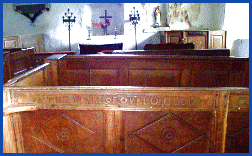
Church and chapel 6
Church and state
A census on religious belief
The Religious Census of 1851 put the church in second place to
nonconformity in Wales, although the substantial minority of
people who did not take part in any religious observance are
often overlooked in the equation.
The Census fuelled the movement for a break between church and state. If the established church only represented a minority of the people in Wales why should it enjoy the power of the state, and why should it enjoy the tithe payments of the mass of nonconformists? The campaign for a separate Church in Wales electing its own bishops was not completely achieved until 1920, but the second half of the nineteenth century was one in which the Anglican Church in Wales rose to the new challenge and experienced its own revival.
Meeting new needs
Between 1870 and 1920 the Welsh bishops - appointed by successive
Prime Ministers - were all Welsh speaking. They successfully
addressed the problems of earlier years like the non-residence
of parish clergy, and this was a period of tremendous church
construction as parishes were re-drawn to meet the needs of a
changing population.
 It
was also the period of the mass renovation of parish churches,
many of which were in a very poor state. Architects like Radnorshire’s
Stephen William Williams and Thomas Nicholson built a career
around these renovations. They had a huge influence on local
architecture, though some now see this period more as that of
the ruination of many parish churches rather than their restoration.
So widespread was the restoration that box pews like those at
Disserth in Radnorshire (above) are today a rare sight
in the churches of Powys.
It
was also the period of the mass renovation of parish churches,
many of which were in a very poor state. Architects like Radnorshire’s
Stephen William Williams and Thomas Nicholson built a career
around these renovations. They had a huge influence on local
architecture, though some now see this period more as that of
the ruination of many parish churches rather than their restoration.
So widespread was the restoration that box pews like those at
Disserth in Radnorshire (above) are today a rare sight
in the churches of Powys.
There are 8 pages in this sequence. Use the box links below to view the other pages.